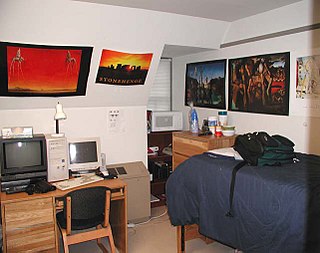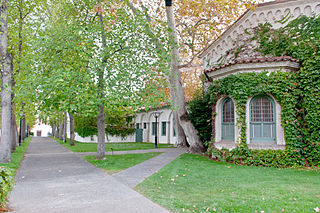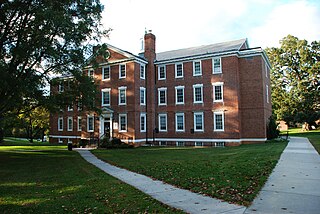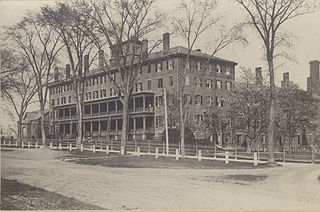This article relies largely or entirely on a single source .(September 2023) |

In higher education, a men's college is an undergraduate, bachelor's degree-granting institution whose students are exclusively men. Many are liberal arts colleges.
This article relies largely or entirely on a single source .(September 2023) |

In higher education, a men's college is an undergraduate, bachelor's degree-granting institution whose students are exclusively men. Many are liberal arts colleges.
In the United States, co-education did not become prevalent until 1900. Prior to that, the majority of private colleges and universities were sex-segregated. There are few remaining men's colleges in the U.S. today. [1] Many of these are religious, vocational institutions.
United States v. Virginia , 518 U.S. 515 (1996)

Title IX is the most commonly used name for the federal civil rights law in the United States that was enacted as part of the Education Amendments of 1972. It prohibits sex-based discrimination in any school or any other education program that receives funding from the federal government. This is Public Law No. 92‑318, 86 Stat. 235, codified at 20 U.S.C. §§ 1681–1688.

Bucknell University is a private liberal arts college in Lewisburg, Pennsylvania. Founded in 1846 as the University at Lewisburg, it now consists of the College of Arts and Sciences, Freeman College of Management, and the College of Engineering. It offers 65 majors and 70 minors in the sciences and humanities. Located just south of Lewisburg, the 445-acre (1.80 km2) campus rises above the West Branch of the Susquehanna River.
In the United States, education is provided in public and private schools and by individuals through homeschooling. State governments set overall educational standards, often mandate standardized tests for K–12 public school systems and supervise, usually through a board of regents, state colleges, and universities. The bulk of the $1.3 trillion in funding comes from state and local governments, with federal funding accounting for about $260 billion in 2021 compared to around $200 billion in past years.
A college-preparatory school is a type of secondary school. The term refers to public, private independent or parochial schools primarily designed to prepare students for higher education.

A dormitory is a building primarily providing sleeping and residential quarters for large numbers of people such as boarding school, high school, college or university students. In some countries, it can also refer to a room containing several beds accommodating people.

Mixed-sex education, also known as mixed-gender education, co-education, or coeducation, is a system of education where males and females are educated together. Whereas single-sex education was more common up to the 19th century, mixed-sex education has since become standard in many cultures, particularly in Western countries. Single-sex education remains prevalent in many Muslim countries. The relative merits of both systems have been the subject of debate.

The University of San Diego (USD) is a private Roman Catholic research university in San Diego, California. Chartered in July 1949 as the independent San Diego College for Women and San Diego University, the two institutions merged in 1972.

Sex segregation, sex separation, gender segregation or gender separation is the physical, legal, or cultural separation of people according to their biological sex at any age. Sex segregation can refer simply to the physical and spatial separation by sex without any connotation of illegal discrimination. In other circumstances, sex segregation can be controversial. Depending on the circumstances, it can be a violation of capabilities and human rights and can create economic inefficiencies; on the other hand, some supporters argue that it is central to certain religious laws and social and cultural histories and traditions.

Women's colleges in higher education are undergraduate, bachelor's degree-granting institutions, often liberal arts colleges, whose student populations are composed exclusively or almost exclusively of women. Some women's colleges admit male students to their graduate schools or in smaller numbers to undergraduate programs, but all serve a primarily female student body.

Single-sex education, also known as single-gender education and gender-isolated education, is the practice of conducting education with male and female students attending separate classes, perhaps in separate buildings or schools. The practice of single-sex schooling was common before the 20th century, particularly in secondary and higher education. Single-sex education is practiced in many parts of the world based on tradition and religion; recently, there has been a surge of interest and the establishment of single-sex schools due to educational research. Single-sex education is most popular in English-speaking countries (regions) such as Singapore, Malaysia, Ireland, the United Kingdom, Hong Kong, South Africa and Australia; also in Chile, Israel, South Korea and in many Muslim majority countries. In the Western world, single-sex education is primarily associated with the private sector, with the public (state) sector being overwhelmingly mixed sex; while in the Muslim world public schools and private schools are sex-segregated. Motivations for single-sex education range from religious ideas of sex segregation to beliefs that the sexes learn and behave differently. As such, they thrive in a single-sex environment. In the 19th century, in Western countries, single-sex girls' finishing schools, and women's colleges offered women a chance of education at a time when they were denied access to mainstream educational institutions. The former was especially common in Switzerland, the latter in the U.S. and the U.K., pioneers in women's education.

Mississippi University for Women is a coeducational public university in Columbus, Mississippi. It was formerly named the Industrial Institute and College for the Education of White Girls and later the Mississippi State College for Women. Men have been admitted to MUW since 1982 and today make up about 20 percent of the student body. As a public liberal arts college, MUW is one of just 30 universities in the United States and Canada to be selected for membership in the Council of Public Liberal Arts Colleges.
In the United States, higher education is an optional stage of formal learning following secondary education. It is also referred as post-secondary education, third-stage, third-level, or tertiary education. It covers stages 5 to 8 on the International ISCED 2011 scale. It is delivered at 4,360 Title IV degree-granting institutions, known as colleges or universities. These may be public or private universities, research universities, liberal arts colleges, community colleges, or for-profit colleges. US higher education is loosely regulated by the government and by several third-party organizations.
The Office for Civil Rights (OCR) is a sub-agency of the U.S. Department of Education that is primarily focused on enforcing civil rights laws prohibiting schools from engaging in discrimination on the basis of race, color, national origin, sex, disability, age, or membership in patriotic youth organizations.

The educational attainment of the U.S. population refers to the highest level of education completed. The educational attainment of the U.S. population is similar to that of many other industrialized countries with the vast majority of the population having completed secondary education and a rising number of college graduates that outnumber high school dropouts. As a whole, the population of the United States is spending more years in formal educational programs. As with income, levels differ by race, age, household configuration, and geography.

Women's colleges in the United States are private single-sex U.S. institutions of higher education that only admit female students. They are often liberal arts colleges. There were approximately 26 active women's colleges in the United States in 2023, down from a peak of 281 such colleges in the 1960s.

Men's colleges in the United States are primarily those categorized as being undergraduate, bachelor's degree-granting single-sex institutions that admit only men. In the United States, male-only undergraduate higher education was the norm until the 1960s. The few remaining well-known men's colleges are traditional independent liberal arts colleges, though at present the majority are institutions of learning for those preparing for religious vocations.
Mississippi University for Women v. Hogan, 458 U.S. 718 (1982), was a landmark decision of the Supreme Court of the United States, decided 5–4, which ruled that the single-sex admissions policy of the Mississippi University for Women violated the Equal Protection Clause of the Fourteenth Amendment to the United States Constitution.

New England Female Medical College (NEFMC), originally Boston Female Medical College, was founded in 1848 by Samuel Gregory and was the first school to train women in the field of medicine. It merged with Boston University to become the Boston University School of Medicine in 1874.
In the early colonial history of the United States, higher education was designed for men only. Since the 1800s, women's positions and opportunities in the educational sphere have increased. Since the late 1970s and early 1980s, women have surpassed men in number of bachelor's degrees and master's degrees conferred annually in the United States and women have continuously been the growing majority ever since, with men comprising a continuously lower minority in earning either degree. The same asymmetry has occurred with Doctorate degrees since 2005 with women being the continuously growing majority and men a continuously lower minority.

A female seminary is a private educational institution for women, popular especially in the United States in the nineteenth and early twentieth centuries, when opportunities in educational institutions for women were scarce. The movement was a significant part of a remarkable transformation in American education in the period 1820–1850. Supporting academic education for women, the seminaries were part of a large and growing trend toward women's 'equality'. Some trace its roots to 1815, and characterize it as at the confluence of various liberation movements. Some of the seminaries gradually developed as four-year colleges.